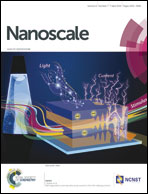Synthesis of wurtzite–zincblende Cu2ZnSnS4 and Cu2ZnSnSe4 nanocrystals: insight into the structural selection of quaternary and ternary compounds influenced by binary nuclei†
Abstract
Nearly monodispersed wurtzite-dominant Cu2ZnSnS4 and zincblende-dominant Cu2ZnSnSe4 nanocrystals were successfully synthesized by mixing metal salts with heated thiourea or selenourea in oleylamine. A perspective of the structural relationship between quaternary and ternary semiconductors was investigated through the application of different anion sources to prepare Cu2SnS3 and Cu2SnSe3 nanocrystals. Investigations on copper-based binary compounds found that CuSe (or CuS) and Cu2Se (or Cu1.96S, Cu9S5) nuclei were primarily responsible for the formation of zincblende or wurtzite structures, respectively. Further management over these binary intermediates corresponded to slight structural transformations of the quaternary nanocrystals which could be observed not only in XRD patterns, but from optical and electrical properties as well. According to these results, Cu2ZnGeS4 nanocrystals with wurtzite-dominant structures were first reported using SC(NH2)2, which also verified that the binary semiconductors are the determinative factors.


 Please wait while we load your content...
Please wait while we load your content...